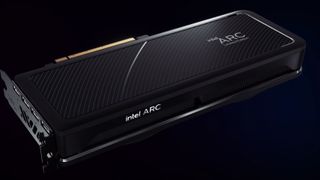Intel Arc A770 matches RTX 2070 OpenCL performance
Not exactly hitting it out of the park.

The launch of Intel's Arc Alchemist series draws closer. We don't yet have a clear understanding of how the various cards will compete with their AMD and Nvidia competitors, but hints are emerging, including a new Geekbench 5 OpenCL benchmark for the Arc A770. The A770 is believed to be the flagship of Arc family.
According to the Geekbench 5 submission, (via Benchleaks and Tom's Hardware), the card has 512 compute units, clocked at a maximum frequency of 2400MHz. The memory is reported at 12.7GB, but that could be a reporting error. If we assume that the reported configuration is otherwise accurate, then this is the full ACM-G10 GPU.
OpenCL is a framework for heterogenous computing across different types of processors, including CPUs and GPUs. It's not an indicator of gaming performance, nevertheless, it gives us a peek at what kind of compute performance the card has against its competitors.
The A770 returns an OpenCL score of 85585. This compares to a GeForce RTX 2070 at 85818 and a Radeon RX 6600 XT at 82559. So, that's not exactly a stellar number for the Intel entry. For example, an RTX 3080 scores around 181,000, while a 6800 XT scores 157,000. It means that the A770 as configured is a long way behind high end AMD and Nvidia offerings. It's possible that the Intel 9600K processor used for the Arc result is causing a performance bottleneck.

Best CPU for gaming: The top chips from Intel and AMD
Best gaming motherboard: The right boards
Best graphics card: Your perfect pixel-pusher awaits
Best SSD for gaming: Get into the game ahead of the rest
Again though, it's important to remember that OpenCL performance isn't reflective of gaming performance. Just look at the 6800 XT and 3080 results above. Though a 3080 holds a healthy lead over a 6800 XT, they are much closer in gaming performance. Pinch of salt required.
Intel is ramping up its marketing campaign. We've seen a few teasers now including a slick preview video, and a demonstration of XeSS, which is Intel's image upscaling technology. The company has also talked a little about its video engine, which includes full AV1 encode and decode support.
What remains to be seen is actual real-world gaming performance. Only then will we have a better understanding of just how Intel's first generation of GPUs stand up against those from AMD and Nvidia. We can expect the cards to launch sometime over the summer, or winter for our southern hemisphere friends.
The biggest gaming news, reviews and hardware deals
Keep up to date with the most important stories and the best deals, as picked by the PC Gamer team.

Chris' gaming experiences go back to the mid-nineties when he conned his parents into buying an 'educational PC' that was conveniently overpowered to play Doom and Tie Fighter. He developed a love of extreme overclocking that destroyed his savings despite the cheaper hardware on offer via his job at a PC store. To afford more LN2 he began moonlighting as a reviewer for VR-Zone before jumping the fence to work for MSI Australia. Since then, he's gone back to journalism, enthusiastically reviewing the latest and greatest components for PC & Tech Authority, PC Powerplay and currently Australian Personal Computer magazine and PC Gamer. Chris still puts far too many hours into Borderlands 3, always striving to become a more efficient killer.
Most Popular





